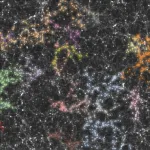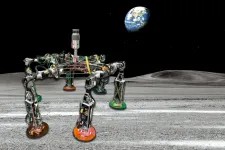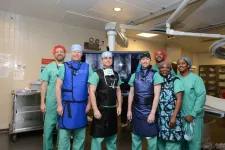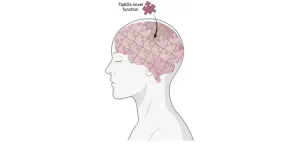(Press-News.org) In late 2021, Salvatore Torquato, on sabbatical from Princeton’s Department of Chemistry, reached across the aisle as it were and invited a young astrophysicist at the Institute for Advanced Study to apply the tools of statistical mechanics to his own work on the distribution of galaxies.
The astrophysicist, Oliver Philcox, now a postdoc at the Simons Foundation, was intrigued. A year-long collaboration ensued.
The questions at the heart of their unusual partnership were straightforward: can the statistical descriptors Torquato has worked with throughout his career find application in unlikely places like cosmology, and can they accurately characterize the complexity in the distribution of galaxies? The answer to both questions: yes, indeed.
Their collaboration came to fruition this week with a paper in Physical Review X, “The Disordered Heterogeneous Universe: Galaxy Distribution and Clustering Across Length Scales.” In it, the researchers demonstrate they can uncover useful information about the spatial distribution of galaxies from a few descriptors more commonly used to classify the microstructure of materials.
Astrophysicists have long explored questions about the large-scale structure of the Universe through standard tools of physical cosmology. What Torquato and Philcox did was offer proof that a new array of descriptors can be used to characterize structural data across length scales, from the atomic scale to the largest scale in the Universe … including the Universe.
Torquato uses the word “zoology” to capture the array of theoretical and computational techniques he uses in his work. What he means is: applying statistical descriptors that describe complex materials microstructures to determine their physical and chemical properties at the macroscale.
Applying these techniques on the largest scale to locate similarities, Torquato and Philcox treated galaxies as a cloud of individual points akin to particles in a material.
“So, okay, I have two regions of space: it can be the galaxies and then everything outside the galaxies. Among other things, you can study the holes between the galaxies similarly to the way you would study the structure of materials,” said Torquato, a theoretical chemist and the Lewis Bernard Professor of Natural Sciences, Professor of Chemistry and the Princeton Materials Institute..
“If I say, I want to put a ball between the galaxies that doesn’t touch any of the galaxies, how big a ball do I need? You could apply that statistical question to any complicated structure, whether it’s the distribution of galaxies or the distribution of atoms. That’s the beauty of it.
“Interestingly,” he added, “the unique structure of the Universe provides new challenges to ascertain even better descriptors for describing terrestrial materials.”
Philcox, formerly a graduate student in Princeton’s Department of Astrophysical Sciences, embraced this “zoology” to enlarge his own toolbox. A key example was his use of the pair-connectedness function, which Philcox defines as a particular way to characterize materials by looking at the distribution of pairs of points.
“Delving into the zoology with Sal certainly led to some interesting discoveries of statistics used in materials science that could be used in cosmology, but hadn’t yet, the pair-connectedness function being the most notable one,” said Philcox. “Conventional cosmological statistics answer the question: if I pick two points at random, what is their separation, probabilistically?
“The pair-connectedness function does a similar thing but includes topological information. Essentially, it groups the particles in a material into connected structures, then looks at the distribution of separations between two points within that structure, rather than globally.”
Using this and other functions, researchers were able to generate tables of numbers that served as a measure of order or disorder across length scales. When applied to questions of spatial relationships between galaxies, the tools underscored a kind of correlated disorder – a complex structural property that is “definitely” not random.
“We’re asking exactly the same questions about large-scale structure that cosmologists have always asked using more standard descriptors: how do we describe this structure; how do we characterize it; how do we quantify it; what can we get from it in terms of the physics,” Torquato said. “We’re just using some new theoretical tools to do so.”
Added Philcox: “I think it’s an important message that there are some conceptually very simple tools that can allow us to extract new information about the Universe, particularly with regard to its clustering, that are quite orthogonal to what’s already used. We’re excited to see how these can be used in practice.”
END
Princeton Chem, IAS uncover spatial patterns in distribution of galaxies
In an unlikely pairing, a Princeton Chemist and an astrophysicist studying at the Institute for Advanced Study applied the tools of statistical mechanics to find similarities in spatial patterns across length scales.
2023-03-14
ELSE PRESS RELEASES FROM THIS DATE:
Researchers look to AI for decision-making in extreme situations
2023-03-14
Imagine you are a doctor managing the emergency room of a large hospital. You suddenly get a call reporting a mass shooting at a nearby concert. In 20 minutes, you will be responsible for triaging more than 200 patients with a range of injuries. You do not have enough staff or resources and the hospital policies are not designed for a situation this dire.
“When people respond to emergencies, many decisions they face are quite predictable. They’re trained on them, and there’s policy,” said UMass Lowell’s Neil Shortland, associate professor in the School of Criminology and Justice Studies. “But every now and then, they get stuck with a really ...
Mix-and-match kit could enable astronauts to build a menagerie of lunar exploration bots
2023-03-14
When astronauts begin to build a permanent base on the moon, as NASA plans to do in the coming years, they’ll need help. Robots could potentially do the heavy lifting by laying cables, deploying solar panels, erecting communications towers, and building habitats. But if each robot is designed for a specific action or task, a moon base could become overrun by a zoo of machines, each with its own unique parts and protocols.
To avoid a bottleneck of bots, a team of MIT engineers is designing a kit of universal ...
Common dry cleaning chemical linked to Parkinson’s
2023-03-14
A common and widely used chemical may be fueling the rise of the world’s fastest growing brain condition – Parkinson’s disease. For the past 100 years, trichloroethylene (TCE) has been used to decaffeinate coffee, degrease metal, and dry clean clothes. It contaminates the Marine Corps base Camp Lejeune, 15 toxic Superfund sites in Silicon Valley, and up to one-third of groundwater in the U.S. TCE causes cancer, is linked to miscarriages and congenital heart disease, and is associated ...
Molecular component of caffeine may play a role in gut health
2023-03-14
Brigham researchers studying how and why certain cell types proliferate in the gut found that xanthine, which is found in coffee, tea and chocolate, may play a role in Th17 differentiation
Insights may help investigators better understand gut health and the development of conditions such as inflammatory bowel disease
The gut is home to a cast of microbes that influence health and disease. Some types of microorganisms are thought to contribute to the development of inflammatory conditions, such as inflammatory bowel disease (IBD), but the exact cascade of events that leads from microbes to immune cells to disease remains ...
Ochsner Health announces new Aortic Center; subscribes to cutting-edge imaging with Cydar Technology
2023-03-14
NEW ORLEANS, La. – Global death rates from aortic diseases have steadily increased over the past two decades. Studies show up to 8% of individuals will develop an aortic aneurysm during their lifetime, higher than rates of colon and lung cancer combined, and over 80% of ruptured aortic aneurysms cause sudden death.
To save lives and improve outcomes for patients with aortic disease of all kinds, Ochsner Health is excited to announce the establishment of The Ochsner Aortic Center. Outfitted with cutting-edge imaging technology that allows medical staff to make faster, easier, and safer decisions, this dedicated, comprehensive aortic center is now the ...
Aston Pharmacy School researchers develop new technique mixing oil and water to improve drug delivery
2023-03-14
A team of researchers from Aston University has developed a new technique that could be a game changer for the medical and drinks industries.
The technology enables insoluble drug/oil to be dissolved in water. The technique is novel because it doesn’t just mix the two together to make an emulsion, it makes oil soluble in water and has the potential to revolutionise a variety of medical treatments and improve drug delivery.
The technique was developed with Max Bio+ a spin out company founded by Professor Sunil Shah, a consultant ...
New guideline introduces recommendations for optimal timing of elective hip or knee arthroplasty
2023-03-14
ATLANTA — The American College of Rheumatology (ACR) and the American Association of Hip and Knee Surgeons (AAHKS) released a summary of its new guideline titled “the Optimal Timing of Elective Hip or Knee Arthroplasty for Patients with Symptomatic Moderate to Severe Osteoarthritis or Osteonecrosis Who Have Failed Nonoperative Therapy.” The ACR and AAHKS have worked together before, creating guidelines for Perioperative Management of Antirheumatic Medication in Patients with Rheumatic Diseases Undergoing Elective Total Hip or Total Knee Arthroplasty in 2017 and 2022. While those guidelines focus on which medications ...
Solving the Alzheimer’s disease puzzle: One piece at a time
2023-03-14
Researchers from Drexel University have uncovered a novel regulatory mechanism in the brain that is essential for making the right kinds of proteins that promote healthy brain function, and its malfunctioning may be an early contributor of the development of Alzheimer’s disease.
Brain cells are continuously undergoing changes in response to environmental stimuli and to record new memories. Such complex brain capability relies on the ability of brain cells to generate different functional variants of the same protein using a process known as alternative RNA splicing.
Recent studies have reported defects ...
Stephen Fantone elected chair of Hertz Foundation’s board of directors
2023-03-14
The Fannie and John Hertz Foundation, a nonprofit organization dedicated to empowering the most promising innovators in science and technology, has announced the election of Stephen D. Fantone as chair of its board of directors.
Fantone is the founder and president of Optikos Corporation, which provides innovative applications of optical technology, both products and services, to commercial, government and consumer products organizations worldwide. Fantone is a recognized expert in optical engineering and optical product ...
WVU lab’s game-changing high-performance semiconductor material could help slash heat emissions
2023-03-14
Researchers at West Virginia University have engineered a material with the potential to dramatically cut the amount of heat power plants release into the atmosphere.
A team led by Xueyan Song, professor and George B. Berry Chair of Engineering at the Benjamin M. Statler College of Engineering and Mineral Resources, has created an oxide ceramic material that solves a longstanding efficiency problem plaguing thermoelectric generators. Those devices can generate electricity from heat, including power plant heat emissions, which contribute to global warming.
The breakthrough ...
LAST 30 PRESS RELEASES:
Making lighter work of calculating fluid and heat flow
Normalizing blood sugar can halve heart attack risk
Lowering blood sugar cuts heart attack risk in people with prediabetes
Study links genetic variants to risk of blinding eye disease in premature infants
Non-opioid ‘pain sponge’ therapy halts cartilage degeneration and relieves chronic pain
AI can pick up cultural values by mimicking how kids learn
China’s ecological redlines offer fast track to 30 x 30 global conservation goal
Invisible indoor threats: emerging household contaminants and their growing risks to human health
Adding antibody treatment to chemo boosts outcomes for children with rare cancer
Germline pathogenic variants among women without a history of breast cancer
Tanning beds triple melanoma risk, potentially causing broad DNA damage
Unique bond identified as key to viral infection speed
Indoor tanning makes youthful skin much older on a genetic level
Mouse model sheds new light on the causes and potential solutions to human GI problems linked to muscular dystrophy
The Journal of Nuclear Medicine ahead-of-print tip sheet: December 12, 2025
Smarter tools for peering into the microscopic world
Applications open for funding to conduct research in the Kinsey Institute archives
Global measure underestimates the severity of food insecurity
Child survivors of critical illness are missing out on timely follow up care
Risk-based vs annual breast cancer screening / the WISDOM randomized clinical trial
University of Toronto launches Electric Vehicle Innovation Ontario to accelerate advanced EV technologies and build Canada’s innovation advantage
Early relapse predicts poor outcomes in aggressive blood cancer
American College of Lifestyle Medicine applauds two CMS models aligned with lifestyle medicine practice and reimbursement
Clinical trial finds cannabis use not a barrier to quitting nicotine vaping
Supplemental nutrition assistance program policies and food insecurity
Switching immune cells to “night mode” could limit damage after a heart attack, study suggests
URI-based Global RIghts Project report spotlights continued troubling trends in worldwide inhumane treatment
Neutrophils are less aggressive at night, explaining why nighttime heart attacks cause less damage than daytime events
Menopausal hormone therapy may not pose breast cancer risk for women with BRCA mutations
Mobile health tool may improve quality of life for adolescent and young adult breast cancer survivors
[Press-News.org] Princeton Chem, IAS uncover spatial patterns in distribution of galaxiesIn an unlikely pairing, a Princeton Chemist and an astrophysicist studying at the Institute for Advanced Study applied the tools of statistical mechanics to find similarities in spatial patterns across length scales.






